- GCN/BACODINE POSITION NOTICE
TITLE: GCN/SWIFT NOTICE
NOTICE_DATE: Thu 06 Jun 13 21:05:02 UT
NOTICE_TYPE: Swift-BAT GRB Position
TRIGGER_NUM: 557589, Seg_Num: 0
GRB_RA: 249.403d {+16h 37m 37s} (J2000),
249.535d {+16h 38m 08s} (current),
248.912d {+16h 35m 39s} (1950)
GRB_DEC: +29.791d {+29d 47' 27"} (J2000),
+29.765d {+29d 45' 53"} (current),
+29.890d {+29d 53' 24"} (1950)
GRB_ERROR: 3.00 [arcmin radius, statistical only]
GRB_INTEN: 3621 [cnts] Image_Peak=191 [image_cnts]
TRIGGER_DUR: 1.024 [sec]
TRIGGER_INDEX: 146 E_range: 25-100 keV
BKG_INTEN: 21682 [cnts]
BKG_TIME: 75861.35 SOD {21:04:21.35} UT
BKG_DUR: 8 [sec]
GRB_DATE: 16449 TJD; 157 DOY; 13/06/06
GRB_TIME: 75879.02 SOD {21:04:39.02} UT
GRB_PHI: -158.77 [deg]
GRB_THETA: 22.72 [deg]
SOLN_STATUS: 0x3
RATE_SIGNIF: 15.09 [sigma]
IMAGE_SIGNIF: 8.14 [sigma]
MERIT_PARAMS: +1 +0 +0 +0 +2 -2 +0 +0 +60 +0
SUN_POSTN: 75.13d {+05h 00m 31s} +22.73d {+22d 43' 59"}
SUN_DIST: 127.23 [deg] Sun_angle= -11.6 [hr] (East of Sun)
MOON_POSTN: 54.58d {+03h 38m 18s} +18.50d {+18d 30' 03"}
MOON_DIST: 129.63 [deg]
MOON_ILLUM: 3 [%]
GAL_COORDS: 50.12, 40.72 [deg] galactic lon,lat of the burst (or transient)
ECL_COORDS: 240.86, 51.17 [deg] ecliptic lon,lat of the burst (or transient)
COMMENTS: SWIFT-BAT GRB Coordinates.
COMMENTS: This is a rate trigger.
COMMENTS: A point_source was found.
COMMENTS: This does not match any source in the on-board catalog.
COMMENTS: This does not match any source in the ground catalog.
COMMENTS: This is a GRB.
COMMENTS: This trigger occurred at longitude,latitude = 67.58,-5.88 [deg].
- red DSS finding chart
ps-file
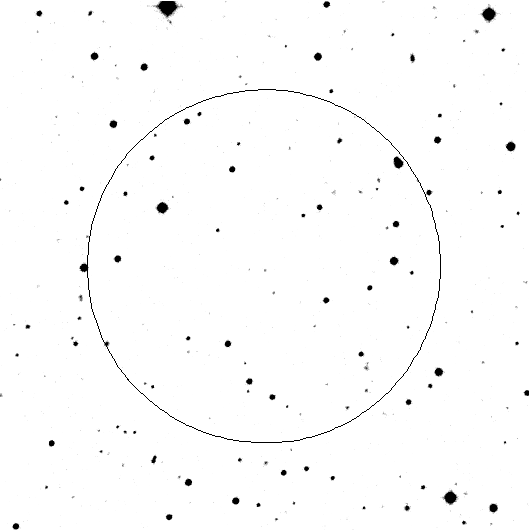
- GCN NOTICE
TITLE: GCN/INTEGRAL NOTICE
NOTICE_DATE: Thu 06 Jun 13 21:03:19 UT
NOTICE_TYPE: INTEGRAL SPI ACS Trigger
TRIGGER_NUM: 6858, Sub_Num: 0
GRB_INTEN: 10.28 [sigma]
GRB_TIME: 75766.43 SOD {21:02:46.43} UT
GRB_DATE: 16449 TJD; 157 DOY; 13/06/06
COMMENTS: INTEGRAL SPI_ACS GRB Trigger.
COMMENTS: Time_Scale=0.1000 and Time_Error=0.0500.
COMMENTS: The SPIACS lightcurve can be found at:
COMMENTS: ftp://isdcarc.unige.ch/arc/FTP/ibas/spiacs/2013-06/2013-06-06T21-02-46.2286-02204-19344-0.lc
- GCN NOTICE
TITLE: GCN/SWIFT NOTICE
NOTICE_DATE: Thu 06 Jun 13 21:06:23 UT
NOTICE_TYPE: Swift-XRT Position
TRIGGER_NUM: 557589, Seg_Num: 0
GRB_RA: 249.3996d {+16h 37m 35.90s} (J2000),
249.5316d {+16h 38m 07.58s} (current),
248.9084d {+16h 35m 38.00s} (1950)
GRB_DEC: +29.7949d {+29d 47' 41.6"} (J2000),
+29.7687d {+29d 46' 07.2"} (current),
+29.8940d {+29d 53' 38.3"} (1950)
GRB_ERROR: 5.2 [arcsec radius, statistical plus systematic, 90% containment]
GRB_INTEN: 1.64e-09 [erg/cm2/sec]
GRB_SIGNIF: 7.81 [sigma]
IMG_START_DATE: 16449 TJD; 157 DOY; 13/06/06
IMG_START_TIME: 75951.45 SOD {21:05:51.45} UT, 72.4 [sec] since BAT Trigger Time
TAM[0-3]: 327.66 237.22 261.61 243.66
AMPLIFIER: 2
WAVEFORM: 134
SUN_POSTN: 75.13d {+05h 00m 32s} +22.73d {+22d 43' 59"}
SUN_DIST: 127.22 [deg] Sun_angle= -11.6 [hr] (East of Sun)
MOON_POSTN: 54.59d {+03h 38m 21s} +18.50d {+18d 30' 09"}
MOON_DIST: 129.63 [deg]
MOON_ILLUM: 3 [%]
GAL_COORDS: 50.13, 40.72 [deg] galactic lon,lat of the burst
ECL_COORDS: 240.86, 51.17 [deg] ecliptic lon,lat of the burst
COMMENTS: SWIFT-XRT Coordinates.
COMMENTS: The XRT position is 0.30 arcmin from the BAT position.
- GCN NOTICE
TITLE: GCN/SWIFT NOTICE
NOTICE_DATE: Thu 06 Jun 13 21:06:37 UT
NOTICE_TYPE: Swift-XRT Image
TRIGGER_NUM: 557589, Seg_Num: 0
GRB_RA: 249.3996d {+16h 37m 35.9s} (J2000),
249.5316d {+16h 38m 07.5s} (current),
248.9084d {+16h 35m 38.0s} (1950)
GRB_DEC: +29.7949d {+29d 47' 41.6"} (J2000),
+29.7687d {+29d 46' 07.2"} (current),
+29.8940d {+29d 53' 38.3"} (1950)
GRB_ERROR: 5.0 [arcsec, radius, statistical plus systematic]
GRB_INTEN: 61 [cnts]
IMG_START_DATE: 16449 TJD; 157 DOY; 13/06/06
IMG_START_TIME: 75951.45 SOD {21:05:51.45} UT, 72.4 [sec] since BAT Trigger Time
CENTROID_X: 286.02, raw= 286 [pixels]
CENTROID_Y: 306.32, raw= 306 [pixels]
ROLL: 353.33 [deg]
GAIN: 1
MODE: 3, Long Image mode
WAVEFORM: 134
EXPO_TIME: 2.50 [sec]
GRB_POS_XRT_Y: 19.63
GRB_POS_XRT_Z: -41.66
IMAGE_URL: sw00557589000msxps_rw.img
SUN_POSTN: 75.13d {+05h 00m 32s} +22.73d {+22d 43' 59"}
SUN_DIST: 127.22 [deg] Sun_angle= -11.6 [hr] (East of Sun)
MOON_POSTN: 54.59d {+03h 38m 21s} +18.50d {+18d 30' 10"}
MOON_DIST: 129.63 [deg]
MOON_ILLUM: 3 [%]
GAL_COORDS: 50.13, 40.72 [deg] galactic lon,lat of the burst
ECL_COORDS: 240.86, 51.17 [deg] ecliptic lon,lat of the burst
COMMENTS: SWIFT-XRT Image.

- GCN NOTICE
TITLE: GCN/SWIFT NOTICE
NOTICE_DATE: Thu 06 Jun 13 21:06:45 UT
NOTICE_TYPE: Swift-XRT Processed Image
TRIGGER_NUM: 557589, Seg_Num: 0
GRB_RA: 249.3996d {+16h 37m 35.9s} (J2000),
249.5316d {+16h 38m 07.5s} (current),
248.9084d {+16h 35m 38.0s} (1950)
GRB_DEC: +29.7949d {+29d 47' 41.6"} (J2000),
+29.7687d {+29d 46' 07.2"} (current),
+29.8940d {+29d 53' 38.3"} (1950)
GRB_ERROR: 5.0 [arcsec, radius, statistical plus systematic]
GRB_INTEN: 61 [cnts]
IMG_START_DATE: 16449 TJD; 157 DOY; 13/06/06
IMG_START_TIME: 75951.45 SOD {21:05:51.45} UT, 72.4 [sec] since BAT Trigger Time
CENTROID_X: 286.02, raw= 286 [pixels]
CENTROID_Y: 306.32, raw= 306 [pixels]
ROLL: 353.33 [deg]
GAIN: 1
MODE: 3, Long Image mode
WAVEFORM: 134
EXPO_TIME: 2.50 [sec]
GRB_POS_XRT_Y: 19.63
GRB_POS_XRT_Z: -41.66
IMAGE_URL: sw00557589000msxps_rw.img
SUN_POSTN: 75.13d {+05h 00m 32s} +22.73d {+22d 43' 59"}
SUN_DIST: 127.22 [deg] Sun_angle= -11.6 [hr] (East of Sun)
MOON_POSTN: 54.59d {+03h 38m 22s} +18.50d {+18d 30' 11"}
MOON_DIST: 129.63 [deg]
MOON_ILLUM: 3 [%]
GAL_COORDS: 50.13, 40.72 [deg] galactic lon,lat of the burst
ECL_COORDS: 240.86, 51.17 [deg] ecliptic lon,lat of the burst
COMMENTS: SWIFT-XRT Processed Image.

- GCN NOTICE
TITLE: GCN/SWIFT NOTICE
NOTICE_DATE: Thu 06 Jun 13 21:08:37 UT
NOTICE_TYPE: Swift-BAT GRB Lightcurve
TRIGGER_NUM: 557589, Seg_Num: 0
GRB_RA: 249.403d {+16h 37m 37s} (J2000),
249.535d {+16h 38m 08s} (current),
248.912d {+16h 35m 39s} (1950)
GRB_DEC: +29.791d {+29d 47' 27"} (J2000),
+29.765d {+29d 45' 53"} (current),
+29.890d {+29d 53' 24"} (1950)
GRB_DATE: 16449 TJD; 157 DOY; 13/06/06
GRB_TIME: 75879.02 SOD {21:04:39.02} UT
TRIGGER_INDEX: 146
GRB_PHI: -158.77 [deg]
GRB_THETA: 22.72 [deg]
DELTA_TIME: -5.00 [sec]
TRIGGER_DUR: 1.024 [sec]
SOLN_STATUS: 0x3
RATE_SIGNIF: 15.09 [sigma]
IMAGE_SIGNIF: 8.14 [sigma]
LC_URL: sw00557589000msb.lc
SUN_POSTN: 75.13d {+05h 00m 32s} +22.73d {+22d 43' 60"}
SUN_DIST: 127.23 [deg] Sun_angle= -11.6 [hr] (East of Sun)
MOON_POSTN: 54.61d {+03h 38m 26s} +18.51d {+18d 30' 19"}
MOON_DIST: 129.63 [deg]
MOON_ILLUM: 3 [%]
GAL_COORDS: 50.12, 40.72 [deg] galactic lon,lat of the burst (or transient)
ECL_COORDS: 240.86, 51.17 [deg] ecliptic lon,lat of the burst (or transient)
COMMENTS: SWIFT-BAT GRB Lightcurve.
COMMENTS:
COMMENTS: The next comments were copied from the BAT_POS Notice:
COMMENTS: This is a rate trigger.
COMMENTS: A point_source was found.
COMMENTS: This does not match any source in the on-board catalog.
COMMENTS: This does not match any source in the ground catalog.
COMMENTS: This is a GRB.
COMMENTS: This trigger occurred at longitude,latitude = 67.58,-5.88 [deg].
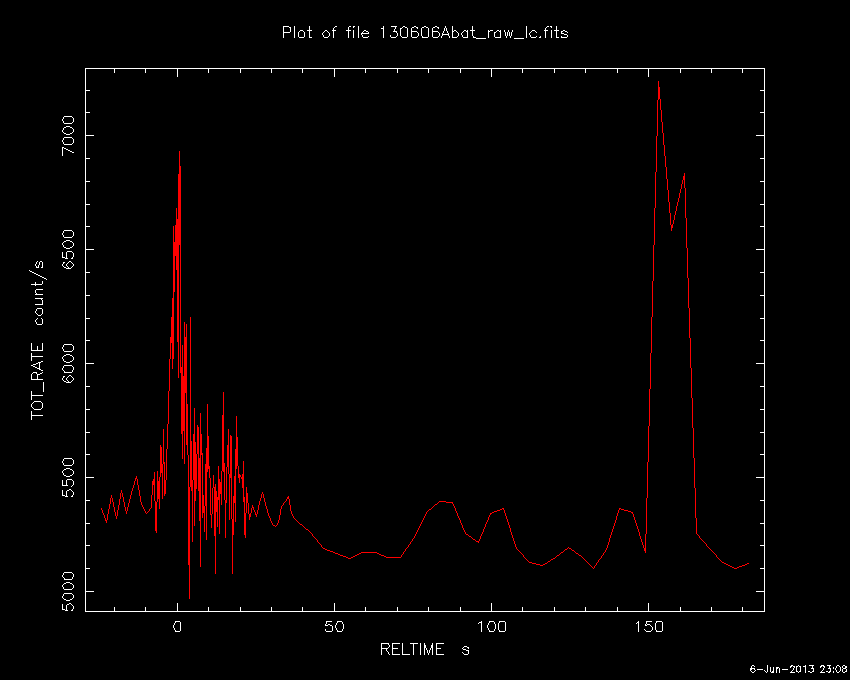
- GCN NOTICE
TITLE: GCN/SWIFT NOTICE
NOTICE_DATE: Thu 06 Jun 13 21:08:58 UT
NOTICE_TYPE: Swift-UVOT Source List
TRIGGER_NUM: 557589, Seg_Num: 0
POINT_RA: 249.408d {+16h 37m 38s} (J2000)
POINT_DEC: +29.784d {+29d 47' 01"} (J2000)
POINT_ROLL: 353.327d
IMG_START_DATE: 16449 TJD; 157 DOY; 13/06/06
IMG_START_TIME: 75959.97 SOD {21:05:59.97} UT, 80.9 [sec] since BAT Trigger Time
FILTER: 10, White
BKG_MEAN: 1.523
N_STARS: 72
X_OFFSET: 520 [pixels]
Y_OFFSET: 488 [pixels]
X_MAX: 1479 [pixels]
Y_MAX: 1447 [pixels]
DET_THRESH: 10
PHOTO_THRESH: 5
SL_URL: sw00557589000msufc0080.fits
SUN_POSTN: 75.13d {+05h 00m 32s} +22.73d {+22d 43' 60"}
SUN_DIST: 127.23 [deg] Sun_angle= -11.6 [hr] (East of Sun)
MOON_POSTN: 54.61d {+03h 38m 26s} +18.51d {+18d 30' 20"}
MOON_DIST: 129.64 [deg]
MOON_ILLUM: 3 [%]
GAL_COORDS: 50.12, 40.71 [deg] galactic lon,lat of the pointing direction
ECL_COORDS: 240.87, 51.16 [deg] ecliptic lon,lat of the pointing direction
COMMENTS: SWIFT-UVOT Source List.
- GCN NOTICE
TITLE: GCN/SWIFT NOTICE
NOTICE_DATE: Thu 06 Jun 13 21:09:21 UT
NOTICE_TYPE: Swift-UVOT Processed Source List
TRIGGER_NUM: 557589, Seg_Num: 0
POINT_RA: 249.408d {+16h 37m 38s} (J2000)
POINT_DEC: +29.784d {+29d 47' 01"} (J2000)
POINT_ROLL: 353.327d
IMG_START_DATE: 16449 TJD; 157 DOY; 13/06/06
IMG_START_TIME: 75959.97 SOD {21:05:59.97} UT, 80.9 [sec] since BAT Trigger Time
FILTER: 10, White
BKG_MEAN: 1.523
N_STARS: 72
X_OFFSET: 520 [pixels]
Y_OFFSET: 488 [pixels]
X_MAX: 1479 [pixels]
Y_MAX: 1447 [pixels]
DET_THRESH: 10
PHOTO_THRESH: 5
SL_URL: sw00557589000msufc0080.fits
SUN_POSTN: 75.13d {+05h 00m 32s} +22.73d {+22d 43' 60"}
SUN_DIST: 127.23 [deg] Sun_angle= -11.6 [hr] (East of Sun)
MOON_POSTN: 54.61d {+03h 38m 27s} +18.51d {+18d 30' 22"}
MOON_DIST: 129.64 [deg]
MOON_ILLUM: 3 [%]
GAL_COORDS: 50.12, 40.71 [deg] galactic lon,lat of the pointing direction
ECL_COORDS: 240.87, 51.16 [deg] ecliptic lon,lat of the pointing direction
COMMENTS: SWIFT-UVOT Processed Source List.
COMMENTS: If you have elected to receive attachments:
COMMENTS: The uvot_catalog_srclist.fits.gz file does not exist; skipping the attachment.
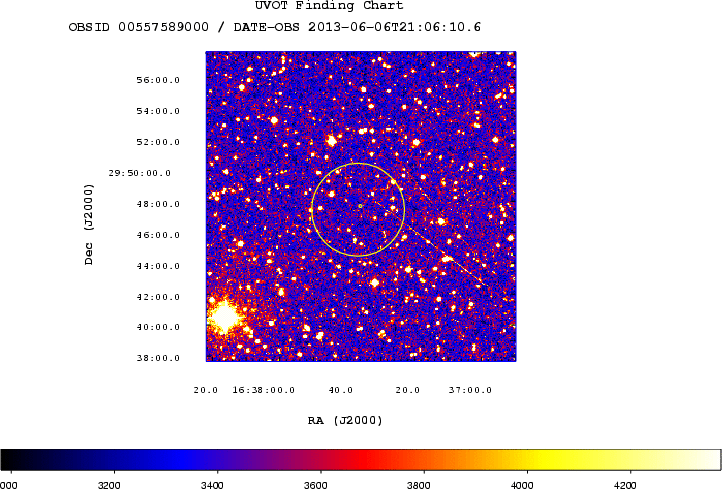
- GCN NOTICE
TITLE: GCN/SWIFT NOTICE
NOTICE_DATE: Thu 06 Jun 13 21:10:11 UT
NOTICE_TYPE: Swift-UVOT Image
TRIGGER_NUM: 557589, Seg_Num: 0
POINT_RA: 249.408d {+16h 37m 38s} (J2000)
POINT_DEC: +29.784d {+29d 47' 01"} (J2000)
ROLL: 353.327d
IMG_START_DATE: 16449 TJD; 157 DOY; 13/06/06
IMG_START_TIME: 75959.97 SOD {21:05:59.97} UT, 80.9 [sec] since BAT Trigger Time
FILTER: 10, White
EXPOSURE_ID: 392245570
X_OFFSET: 854 [pixels]
Y_OFFSET: 777 [pixels]
WIDTH: 160 [pixels]
HEIGHT: 160 [pixels]
X_GRB_POS: 1014
Y_GRB_POS: 937
BINNING_INDEX: 1
IM_URL: sw00557589000msuni0091.fits
SUN_POSTN: 75.13d {+05h 00m 32s} +22.73d {+22d 44' 00"}
SUN_DIST: 127.23 [deg] Sun_angle= -11.6 [hr] (East of Sun)
MOON_POSTN: 54.62d {+03h 38m 29s} +18.51d {+18d 30' 25"}
MOON_DIST: 129.64 [deg]
MOON_ILLUM: 3 [%]
GAL_COORDS: 50.12, 40.71 [deg] galactic lon,lat of the pointing direction
ECL_COORDS: 240.87, 51.16 [deg] ecliptic lon,lat of the pointing direction
COMMENTS: SWIFT-UVOT Image.
COMMENTS: The GRB Position came from the XRT Position Command.
COMMENTS: The image has 2x2 binning (compression).
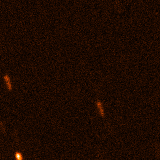
- GCN NOTICE
TITLE: GCN/SWIFT NOTICE
NOTICE_DATE: Thu 06 Jun 13 21:10:29 UT
NOTICE_TYPE: Swift-UVOT Processed Image
TRIGGER_NUM: 557589, Seg_Num: 0
POINT_RA: 249.408d {+16h 37m 38s} (J2000)
POINT_DEC: +29.784d {+29d 47' 01"} (J2000)
ROLL: 353.327d
IMG_START_DATE: 16449 TJD; 157 DOY; 13/06/06
IMG_START_TIME: 75959.97 SOD {21:05:59.97} UT, 80.9 [sec] since BAT Trigger Time
FILTER: 10, White
EXPOSURE_ID: 392245570
X_OFFSET: 854 [pixels]
Y_OFFSET: 777 [pixels]
WIDTH: 160 [pixels]
HEIGHT: 160 [pixels]
X_GRB_POS: 1014
Y_GRB_POS: 937
BINNING_INDEX: 1
IM_URL: sw00557589000msuni0091.fits
SUN_POSTN: 75.13d {+05h 00m 32s} +22.73d {+22d 44' 00"}
SUN_DIST: 127.23 [deg] Sun_angle= -11.6 [hr] (East of Sun)
MOON_POSTN: 54.62d {+03h 38m 29s} +18.51d {+18d 30' 27"}
MOON_DIST: 129.64 [deg]
MOON_ILLUM: 3 [%]
GAL_COORDS: 50.12, 40.71 [deg] galactic lon,lat of the pointing direction
ECL_COORDS: 240.87, 51.16 [deg] ecliptic lon,lat of the pointing direction
COMMENTS: SWIFT-UVOT Processed Image.
COMMENTS: The GRB Position came from the XRT Position Command.
COMMENTS: The image has 2x2 binning (compression).
COMMENTS: If you have elected to receive attachments:
COMMENTS: The uvot_catalog_image.fits.gz file does not exist; skipping the attachment.
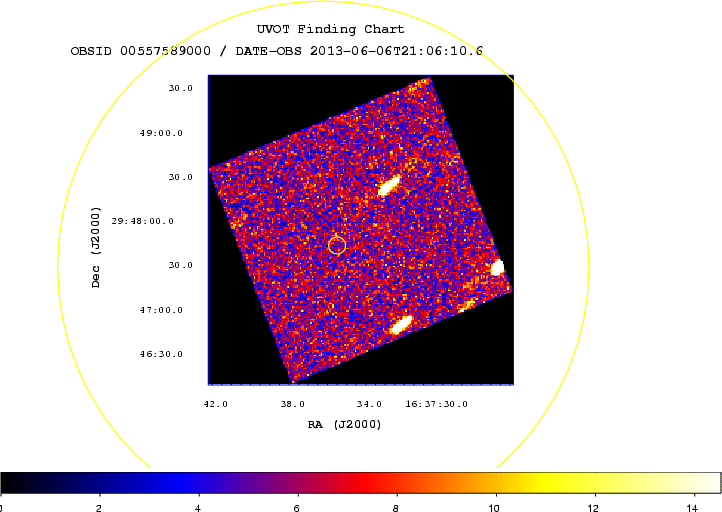
- GCN NOTICE
TITLE: GCN/SWIFT NOTICE
NOTICE_DATE: Thu 06 Jun 13 21:15:54 UT
NOTICE_TYPE: Swift-UVOT Source List
TRIGGER_NUM: 557589, Seg_Num: 0
POINT_RA: 249.411d {+16h 37m 39s} (J2000)
POINT_DEC: +29.782d {+29d 46' 56"} (J2000)
POINT_ROLL: 353.330d
IMG_START_DATE: 16449 TJD; 157 DOY; 13/06/06
IMG_START_TIME: 76172.28 SOD {21:09:32.28} UT, 293.3 [sec] since BAT Trigger Time
FILTER: 7, U
BKG_MEAN: 0.404
N_STARS: 67
X_OFFSET: 534 [pixels]
Y_OFFSET: 457 [pixels]
X_MAX: 1493 [pixels]
Y_MAX: 1416 [pixels]
DET_THRESH: 6
PHOTO_THRESH: 2
SL_URL: sw00557589000msufc0293.fits
SUN_POSTN: 75.14d {+05h 00m 33s} +22.73d {+22d 44' 02"}
SUN_DIST: 127.24 [deg] Sun_angle= -11.6 [hr] (East of Sun)
MOON_POSTN: 54.67d {+03h 38m 41s} +18.51d {+18d 30' 50"}
MOON_DIST: 129.65 [deg]
MOON_ILLUM: 3 [%]
GAL_COORDS: 50.11, 40.71 [deg] galactic lon,lat of the pointing direction
ECL_COORDS: 240.88, 51.16 [deg] ecliptic lon,lat of the pointing direction
COMMENTS: SWIFT-UVOT Source List.
- GCN NOTICE
TITLE: GCN/SWIFT NOTICE
NOTICE_DATE: Thu 06 Jun 13 21:16:14 UT
NOTICE_TYPE: Swift-UVOT Processed Source List
TRIGGER_NUM: 557589, Seg_Num: 0
POINT_RA: 249.411d {+16h 37m 39s} (J2000)
POINT_DEC: +29.782d {+29d 46' 56"} (J2000)
POINT_ROLL: 353.330d
IMG_START_DATE: 16449 TJD; 157 DOY; 13/06/06
IMG_START_TIME: 76172.28 SOD {21:09:32.28} UT, 293.3 [sec] since BAT Trigger Time
FILTER: 7, U
BKG_MEAN: 0.404
N_STARS: 67
X_OFFSET: 534 [pixels]
Y_OFFSET: 457 [pixels]
X_MAX: 1493 [pixels]
Y_MAX: 1416 [pixels]
DET_THRESH: 6
PHOTO_THRESH: 2
SL_URL: sw00557589000msufc0293.fits
SUN_POSTN: 75.14d {+05h 00m 33s} +22.73d {+22d 44' 02"}
SUN_DIST: 127.24 [deg] Sun_angle= -11.6 [hr] (East of Sun)
MOON_POSTN: 54.67d {+03h 38m 41s} +18.51d {+18d 30' 51"}
MOON_DIST: 129.65 [deg]
MOON_ILLUM: 3 [%]
GAL_COORDS: 50.11, 40.71 [deg] galactic lon,lat of the pointing direction
ECL_COORDS: 240.88, 51.16 [deg] ecliptic lon,lat of the pointing direction
COMMENTS: SWIFT-UVOT Processed Source List.
COMMENTS: All 4 attachments are included.
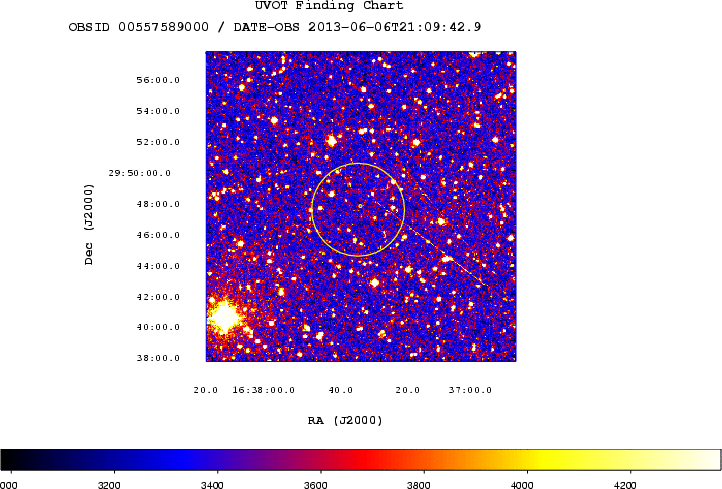
- GCN NOTICE
TITLE: GCN/SWIFT NOTICE
NOTICE_DATE: Thu 06 Jun 13 21:17:16 UT
NOTICE_TYPE: Swift-UVOT Processed Image
TRIGGER_NUM: 557589, Seg_Num: 0
POINT_RA: 249.411d {+16h 37m 39s} (J2000)
POINT_DEC: +29.782d {+29d 46' 56"} (J2000)
ROLL: 353.330d
IMG_START_DATE: 16449 TJD; 157 DOY; 13/06/06
IMG_START_TIME: 76172.28 SOD {21:09:32.28} UT, 293.3 [sec] since BAT Trigger Time
FILTER: 7, U
EXPOSURE_ID: 392245782
X_OFFSET: 854 [pixels]
Y_OFFSET: 777 [pixels]
WIDTH: 160 [pixels]
HEIGHT: 160 [pixels]
X_GRB_POS: 1014
Y_GRB_POS: 937
BINNING_INDEX: 1
IM_URL: sw00557589000msuni0304.fits
SUN_POSTN: 75.14d {+05h 00m 33s} +22.73d {+22d 44' 02"}
SUN_DIST: 127.23 [deg] Sun_angle= -11.6 [hr] (East of Sun)
MOON_POSTN: 54.68d {+03h 38m 44s} +18.52d {+18d 30' 56"}
MOON_DIST: 129.65 [deg]
MOON_ILLUM: 3 [%]
GAL_COORDS: 50.11, 40.71 [deg] galactic lon,lat of the pointing direction
ECL_COORDS: 240.88, 51.16 [deg] ecliptic lon,lat of the pointing direction
COMMENTS: SWIFT-UVOT Processed Image.
COMMENTS: The GRB Position came from the XRT Position Command.
COMMENTS: The image has 2x2 binning (compression).
COMMENTS: All 4 attachments are included.
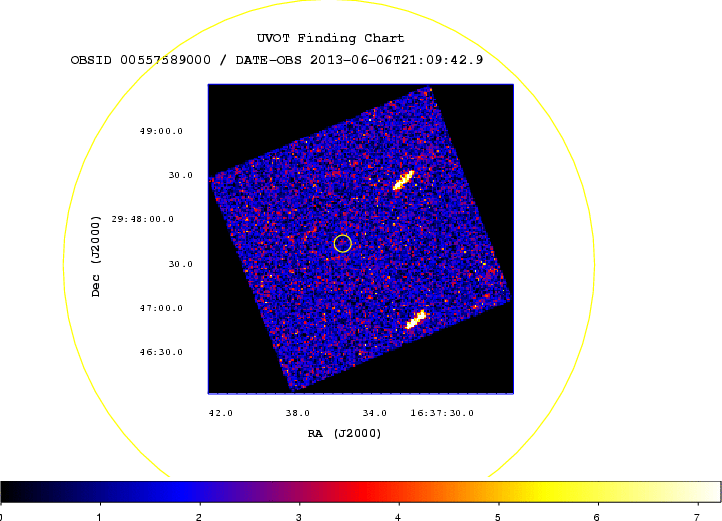
- GCN NOTICE
TITLE: GCN/SWIFT NOTICE
NOTICE_DATE: Thu 06 Jun 13 21:17:05 UT
NOTICE_TYPE: Swift-UVOT Image
TRIGGER_NUM: 557589, Seg_Num: 0
POINT_RA: 249.411d {+16h 37m 39s} (J2000)
POINT_DEC: +29.782d {+29d 46' 56"} (J2000)
ROLL: 353.330d
IMG_START_DATE: 16449 TJD; 157 DOY; 13/06/06
IMG_START_TIME: 76172.28 SOD {21:09:32.28} UT, 293.3 [sec] since BAT Trigger Time
FILTER: 7, U
EXPOSURE_ID: 392245782
X_OFFSET: 854 [pixels]
Y_OFFSET: 777 [pixels]
WIDTH: 160 [pixels]
HEIGHT: 160 [pixels]
X_GRB_POS: 1014
Y_GRB_POS: 937
BINNING_INDEX: 1
IM_URL: sw00557589000msuni0304.fits
SUN_POSTN: 75.14d {+05h 00m 33s} +22.73d {+22d 44' 02"}
SUN_DIST: 127.23 [deg] Sun_angle= -11.6 [hr] (East of Sun)
MOON_POSTN: 54.68d {+03h 38m 43s} +18.52d {+18d 30' 55"}
MOON_DIST: 129.65 [deg]
MOON_ILLUM: 3 [%]
GAL_COORDS: 50.11, 40.71 [deg] galactic lon,lat of the pointing direction
ECL_COORDS: 240.88, 51.16 [deg] ecliptic lon,lat of the pointing direction
COMMENTS: SWIFT-UVOT Image.
COMMENTS: The GRB Position came from the XRT Position Command.
COMMENTS: The image has 2x2 binning (compression).
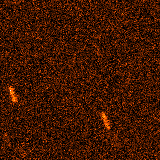
- GCN NOTICE
TITLE: GCN/SWIFT NOTICE
NOTICE_DATE: Thu 06 Jun 13 21:23:22 UT
NOTICE_TYPE: Swift-UVOT Source List
TRIGGER_NUM: 557589, Seg_Num: 0
POINT_RA: 249.410d {+16h 37m 38s} (J2000)
POINT_DEC: +29.783d {+29d 46' 59"} (J2000)
POINT_ROLL: 353.335d
IMG_START_DATE: 16449 TJD; 157 DOY; 13/06/06
IMG_START_TIME: 76750.99 SOD {21:19:10.99} UT, 872.0 [sec] since BAT Trigger Time
FILTER: 10, White
BKG_MEAN: 1.691
N_STARS: 190
X_OFFSET: 294 [pixels]
Y_OFFSET: 217 [pixels]
X_MAX: 1733 [pixels]
Y_MAX: 1656 [pixels]
DET_THRESH: 11
PHOTO_THRESH: 5
SL_URL: sw00557589000msufc0871.fits
SUN_POSTN: 75.14d {+05h 00m 35s} +22.73d {+22d 44' 03"}
SUN_DIST: 127.23 [deg] Sun_angle= -11.6 [hr] (East of Sun)
MOON_POSTN: 54.73d {+03h 38m 56s} +18.52d {+18d 31' 21"}
MOON_DIST: 129.65 [deg]
MOON_ILLUM: 3 [%]
GAL_COORDS: 50.12, 40.71 [deg] galactic lon,lat of the pointing direction
ECL_COORDS: 240.88, 51.16 [deg] ecliptic lon,lat of the pointing direction
COMMENTS: SWIFT-UVOT Source List.
- GCN NOTICE
TITLE: GCN/SWIFT NOTICE
NOTICE_DATE: Thu 06 Jun 13 21:23:44 UT
NOTICE_TYPE: Swift-UVOT Processed Source List
TRIGGER_NUM: 557589, Seg_Num: 0
POINT_RA: 249.410d {+16h 37m 38s} (J2000)
POINT_DEC: +29.783d {+29d 46' 59"} (J2000)
POINT_ROLL: 353.335d
IMG_START_DATE: 16449 TJD; 157 DOY; 13/06/06
IMG_START_TIME: 76750.99 SOD {21:19:10.99} UT, 872.0 [sec] since BAT Trigger Time
FILTER: 10, White
BKG_MEAN: 1.691
N_STARS: 190
X_OFFSET: 294 [pixels]
Y_OFFSET: 217 [pixels]
X_MAX: 1733 [pixels]
Y_MAX: 1656 [pixels]
DET_THRESH: 11
PHOTO_THRESH: 5
SL_URL: sw00557589000msufc0871.fits
SUN_POSTN: 75.14d {+05h 00m 35s} +22.73d {+22d 44' 03"}
SUN_DIST: 127.23 [deg] Sun_angle= -11.6 [hr] (East of Sun)
MOON_POSTN: 54.74d {+03h 38m 57s} +18.52d {+18d 31' 23"}
MOON_DIST: 129.66 [deg]
MOON_ILLUM: 3 [%]
GAL_COORDS: 50.12, 40.71 [deg] galactic lon,lat of the pointing direction
ECL_COORDS: 240.88, 51.16 [deg] ecliptic lon,lat of the pointing direction
COMMENTS: SWIFT-UVOT Processed Source List.
COMMENTS: If you have elected to receive attachments:
COMMENTS: The uvot_catalog_srclist.fits.gz file does not exist; skipping the attachment.
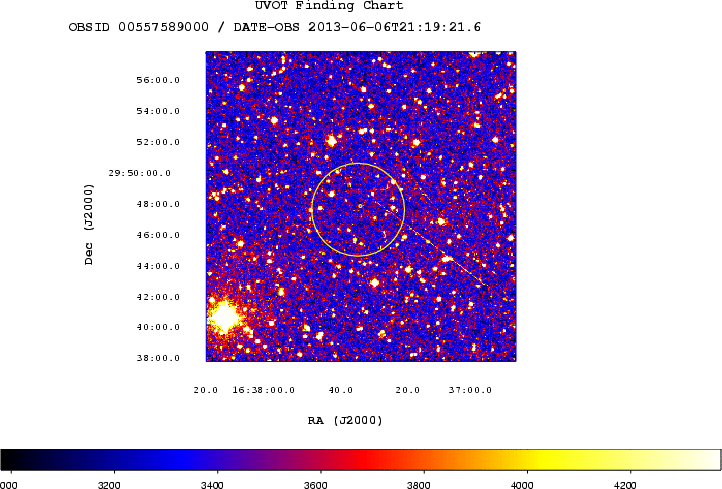
- GCN NOTICE
TITLE: GCN/SWIFT NOTICE
NOTICE_DATE: Thu 06 Jun 13 21:24:43 UT
NOTICE_TYPE: Swift-UVOT Image
TRIGGER_NUM: 557589, Seg_Num: 0
POINT_RA: 249.410d {+16h 37m 38s} (J2000)
POINT_DEC: +29.783d {+29d 46' 59"} (J2000)
ROLL: 353.335d
IMG_START_DATE: 16449 TJD; 157 DOY; 13/06/06
IMG_START_TIME: 76750.99 SOD {21:19:10.99} UT, 872.0 [sec] since BAT Trigger Time
FILTER: 10, White
EXPOSURE_ID: 392246361
X_OFFSET: 853 [pixels]
Y_OFFSET: 776 [pixels]
WIDTH: 160 [pixels]
HEIGHT: 160 [pixels]
X_GRB_POS: 1013
Y_GRB_POS: 936
BINNING_INDEX: 1
IM_URL: sw00557589000msuni0882.fits
SUN_POSTN: 75.14d {+05h 00m 35s} +22.73d {+22d 44' 04"}
SUN_DIST: 127.23 [deg] Sun_angle= -11.6 [hr] (East of Sun)
MOON_POSTN: 54.75d {+03h 38m 59s} +18.52d {+18d 31' 27"}
MOON_DIST: 129.66 [deg]
MOON_ILLUM: 3 [%]
GAL_COORDS: 50.12, 40.71 [deg] galactic lon,lat of the pointing direction
ECL_COORDS: 240.88, 51.16 [deg] ecliptic lon,lat of the pointing direction
COMMENTS: SWIFT-UVOT Image.
COMMENTS: The GRB Position came from the Window Position in the Mode Command.
COMMENTS: The image has 2x2 binning (compression).
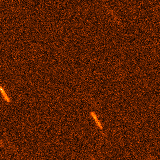
- GCN NOTICE
TITLE: GCN/SWIFT NOTICE
NOTICE_DATE: Thu 06 Jun 13 21:25:10 UT
NOTICE_TYPE: Swift-UVOT Processed Image
TRIGGER_NUM: 557589, Seg_Num: 0
POINT_RA: 249.410d {+16h 37m 38s} (J2000)
POINT_DEC: +29.783d {+29d 46' 59"} (J2000)
ROLL: 353.335d
IMG_START_DATE: 16449 TJD; 157 DOY; 13/06/06
IMG_START_TIME: 76750.99 SOD {21:19:10.99} UT, 872.0 [sec] since BAT Trigger Time
FILTER: 10, White
EXPOSURE_ID: 392246361
X_OFFSET: 853 [pixels]
Y_OFFSET: 776 [pixels]
WIDTH: 160 [pixels]
HEIGHT: 160 [pixels]
X_GRB_POS: 1013
Y_GRB_POS: 936
BINNING_INDEX: 1
IM_URL: sw00557589000msuni0882.fits
SUN_POSTN: 75.15d {+05h 00m 35s} +22.73d {+22d 44' 04"}
SUN_DIST: 127.23 [deg] Sun_angle= -11.6 [hr] (East of Sun)
MOON_POSTN: 54.75d {+03h 39m 00s} +18.52d {+18d 31' 29"}
MOON_DIST: 129.66 [deg]
MOON_ILLUM: 3 [%]
GAL_COORDS: 50.12, 40.71 [deg] galactic lon,lat of the pointing direction
ECL_COORDS: 240.88, 51.16 [deg] ecliptic lon,lat of the pointing direction
COMMENTS: SWIFT-UVOT Processed Image.
COMMENTS: The GRB Position came from the Window Position in the Mode Command.
COMMENTS: The image has 2x2 binning (compression).
COMMENTS: If you have elected to receive attachments:
COMMENTS: The uvot_catalog_image.fits.gz file does not exist; skipping the attachment.
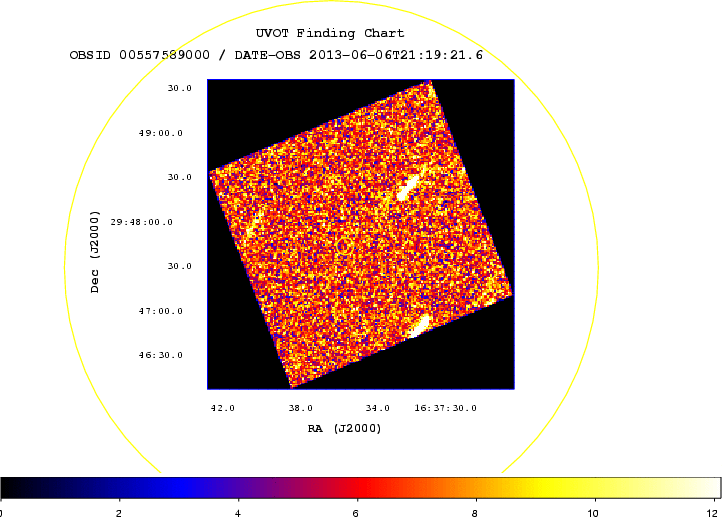
- GCN Circular #14781
T. N. Ukwatta (MSU), S. D. Barthelmy (GSFC), N. Gehrels (NASA/GSFC),
H. A. Krimm (CRESST/GSFC/USRA), D. Malesani (DARK/NBI),
F. E. Marshall (NASA/GSFC), A. Maselli (INAF-IASFPA),
A. Melandri (INAF-OAB), D. M. Palmer (LANL) and
M. Stamatikos (OSU/NASA/GSFC) report on behalf of the Swift Team:
At 21:04:39 UT, the Swift Burst Alert Telescope (BAT) triggered and
located GRB 130606A (trigger=557589). Swift slewed immediately to the burst.
The BAT on-board calculated location is
RA, Dec 249.403, +29.791 which is
RA(J2000) = 16h 37m 37s
Dec(J2000) = +29d 47' 27"
with an uncertainty of 3 arcmin (radius, 90% containment, including
systematic uncertainty). The BAT light curve showed a double-peaked
structure. The initial peak is about 10 sec long from T-5 to T+5 sec.
Then at T+150 sec, there is a second, brighter peak of about 20 sec
duration. The peak count rate was ~2300 counts/sec (15-350 keV),
at ~155 sec after the trigger.
The XRT began observing the field at 21:05:51.4 UT, 72.4 seconds after
the BAT trigger. Using promptly downlinked data we find a bright,
fading, uncatalogued X-ray source located at RA, Dec 249.39916,
29.79428 which is equivalent to:
RA(J2000) = 16h 37m 35.80s
Dec(J2000) = +29d 47' 39.4"
with an uncertainty of 3.6 arcseconds (radius, 90% containment). This
location is 16 arcseconds from the BAT onboard position, within the BAT
error circle. This position may be improved as more data are received;
the latest position is available at http://www.swift.ac.uk/sper.
A power-law fit to a spectrum formed from promptly downlinked event
data gives a column density in excess of the Galactic value (1.98 x
10^20 cm^-2, Kalberla et al. 2005), with an excess column of 3.3
(+1.76/-1.58) x 10^21 cm^-2 (90% confidence).
The initial flux in the 2.5 s image was 1.64e-09 erg cm^-2 s^-1 (0.2-10
keV).
UVOT took a finding chart exposure of 150 seconds with the White filter
starting 80 seconds after the BAT trigger. No credible afterglow candidate has
been found in the initial data products. The 2.7'x2.7' sub-image covers
100% of the XRT error circle. The typical 3-sigma upper limit has been
about 19.6 mag, but the trailed images will reduce the sensitivity slightly.
No correction has been made for the expected extinction corresponding
to E(B-V) of 0.02.
The UVOT data shows stars trailing by about 10 arcseconds, which
may indicate pointing instability at this level. Therefore
this uncertainty should be added to the nominal XRT location
for follow-up searches. A refined aspect solution will be
generated from the full downlinked data.
Burst Advocate for this burst is T. N. Ukwatta (tilan.ukwatta AT gmail.com).
Please contact the BA by email if you require additional information
regarding Swift followup of this burst. In extremely urgent cases, after
trying the Burst Advocate, you can contact the Swift PI by phone (see
Swift TOO web site for information: http://www.swift.psu.edu/too.html.)
- GCN NOTICE
TITLE: GCN/SWIFT NOTICE
NOTICE_DATE: Thu 06 Jun 13 21:36:56 UT
NOTICE_TYPE: Swift-XRT Position UPDATE
TRIGGER_NUM: 557589, Seg_Num: 0
GRB_RA: 249.3990d {+16h 37m 35.76s} (J2000),
249.5310d {+16h 38m 07.44s} (current),
248.9077d {+16h 35m 37.85s} (1950)
GRB_DEC: +29.7942d {+29d 47' 39.1"} (J2000),
+29.7680d {+29d 46' 04.6"} (current),
+29.8933d {+29d 53' 35.7"} (1950)
GRB_ERROR: 3.6 [arcsec radius, statistical plus systematic, 90% containment]
GRB_INTEN: 1.00e-10 [erg/cm2/sec]
GRB_SIGNIF: 10.00 [sigma]
IMG_START_DATE: 16449 TJD; 157 DOY; 13/06/06
IMG_START_TIME: 76383.00 SOD {21:13:03.00} UT, 504.0 [sec] since BAT Trigger Time
TAM[0-3]: 100.00 100.00 100.00 100.00
AMPLIFIER: 1
WAVEFORM: 31
SUN_POSTN: 75.15d {+05h 00m 37s} +22.74d {+22d 44' 07"}
SUN_DIST: 127.22 [deg] Sun_angle= -11.6 [hr] (East of Sun)
MOON_POSTN: 54.85d {+03h 39m 25s} +18.54d {+18d 32' 19"}
MOON_DIST: 129.66 [deg]
MOON_ILLUM: 3 [%]
GAL_COORDS: 50.13, 40.72 [deg] galactic lon,lat of the burst
ECL_COORDS: 240.86, 51.17 [deg] ecliptic lon,lat of the burst
COMMENTS: SWIFT-XRT Coordinates.
COMMENTS: This Notice was ground-generated -- not flight-generated.
COMMENTS: This is an Update Notice -- the RA,Dec values herein supersede the previous XRT_POS Notice.
COMMENTS: TAM values, flux and significance fields are not valid.
COMMENTS: This position was automatically generated on the ground using
COMMENTS: Photon Counting data telemetered via TDRSS (SPER data).
COMMENTS: See http://www.swift.ac.uk/sper/docs.php for details.
COMMENTS: The probability that this is a serendipitous source in the
COMMENTS: SPER window is 0.11% < P(seren) < 0.58%.
- GCN Circular #14782
M. Jelinek (IAA-CSIC), J. Gorosabel (UPV-EY, IAA-CSIC), A. J.
Castro-Tirado (IAA-CSIC), S. Mottola (DLR), S. Hellmich (DLR), R.
Fern=E1ndez-Mu=F1oz (EELM-CSIC) and V. F. Mu=F1oz-Mart=EDnez (UMA), on
behalf of a
larger collaboration, report:
"Following the detection of GRB 130606 by Swift (Ukwatta et al. GCNC
14781), follow-up observation were taken with the 0.6m TELMA telescope at
the BOOTES-2 station (M=E1laga) and with the 1.23m CAHA telescope at the
German-Spanish Calar Alto Observatory, starting 21m postburst. At the edge
of the Swift/XRT error box we identify an optical source not present in
the DSS-2 with a magnitude of R about 18.5 which we identify as the
optical afterglow."
- GCN Circular #14783
D. Xu (DARK/NBI), D. Malesani (DARK/NBI), S. Schulze (PUC and MCSS),
N. R Tanvir (U. Leicester), D. J. Watson (DARK/NBI), J. Hjorth
(DARK/NBI), J. Datson (Tuorla Observatory, U. Turku), R. Salinas
(FINCA) report on behalf of a larger collaboration:
We observed the field of GRB 130606A (Ukwatta et al., GCN 14781) using
the 2.5m Nordic Optical Telescope (NOT) equipped with the MOSCA
imager. Observations started at 21:35 UT on 2013-06-06 (i.e., 0.5 hr
after the burst) and 2x300 s frames were obtained in the Sloan
r-filter.
Close to the refined XRT position, we detect an object not visible in
the DSS and SDSS images of the field, at the following coordinates:
RA (J2000) = 16:37:35.188
Dec(J2000) = +29:47:47.03
These coordinates are formally outside the XRT error circle, which is
however affected by extra systematic uncertainties due to the problems
in the satellite attitude (Ukwatta et al., GCN 14781). The object has
m(r) = 20.8, calibrated against the SDSS.
We suggest this object is the afterglow of GRB 130606A. It is probably
the same object reported by Jelinek et al. (GCN 14782).
- GCN Circular #14784
Takahiro Nagayama (Nagoya Univ) on behalf of OISTER collaboration.
We observed the field of GRB 130606A (Ukwatta et al, GCN Circular
14781) with the Infrared Survey Facility 1.4m telescope and
NIR camera SIRIUS at Sutherland Observatory in South Africa.
The observation was started with the JHKs bands simultaneously
from 2013-06-06 21:38 (UT).
We have detected a bright source not detected in 2MASS ALL SKY survey
at RA=16:37:35.14 DEC=+29:47:46.4 (J2000) from the first 300sec
exposure image.
Preliminary photometry results are as follows
J=13.1
H=13.9
Ks=14.7
These magnitudes are in the Vega system and not corrected for
Galactic extinction in the direction of the GRB.
- GCN Circular #14785
F.J. Virgili, C.G. Mundell (LJMU), A. Melandri (INAF-OAB) report:
"The 2-m Liverpool Telescope robotically followed up GRB 130606A
(SWIFT trigger 557589; Ukwatta et al., GCN 14781) 38.52 min after the
GRB trigger time.
We detect a fading source in i' and z' bands consistent with the
position reported by Xu et al. (GCN 14783) with magnitudes
Filter Magnitude t since trigger (min)
i' 18.60 +/- 0.02 45.02
i' 18.67 +/- 0.02 55.48
i' 18.89 +/- 0.03 83.00
z' 16.65 +/- 0.02 47.74
z' 16.80 +/- 0.03 61.47
Magnitudes are calibrate against SDSS catalogued field stars.
Observations and analysis are ongoing.
- GCN Circular #14789
G. Masi (Ceccano, Italy) and F. Nocentini (Frosinone, Italy) report:
On June 6.96456 2013 UT, we imaged the field around GRB 130606A (Ukwatta et al.
(GCN 14781) remotely using the the 0.43m-f/6.8 robotic unit part of the Virtual
Telescope robotic facility in Italy, 124 minutes after the burst.
4, 300 seconds unfiltered CCD images were coadded and show an object at the
following coordinates (J2000.0):
R.A. = 16 37 35.13
Decl. +29 47 46.7
We also performed photometry, assuming R-mags from UCAC-4 for the stars in the
field, getting an estimate for the magnitude of 19.6 (CR).
- GCN Circular #14790
A. J. Castro-Tirado, R. S=E1nchez-Ram=EDrez, M. Jelinek (IAA-CSIC), J.
Gorosabel (EHU-UPV), J. C. Tello, P. Ferrero, O. Lara-Gil, R. Cunniffe
(IAA-CSIC), D. P=E9rez-Ram=EDrez (U. Ja=E9n), P. Kubanek (FZU), J. M. Cas=
tro
Cer=F3n (ESAC), A. Fern=E1ndez-Soto (UV), S. Mottola (DLR), S. Hellmich (=
DLR),
R. Fern=E1ndez-Mu=F1oz (EELM-CSIC), V. F. Mu=F1oz-Mart=EDnez (UMA), J. Ce=
pa (IAC)
and C. =C1lvarez-Iglesias (GTC), on behalf of a larger collaboration,
report:
=93Following the detection of the optical afterglow (Jelinek et al. GCNC
14782, Xu et al. GCNC 14783) to GRB 130606A ((Ukwatta et al. GCNC
14781), we have obtained an optical spectrum with the 10.4 m GTC (+OSIRIS=
)
starting aprox. 1.5 hr postburst, covering the 4000-10000 wavelength
range. The continuum is detected only redwards of aprox. 6500 A, with
multiple absorption lines which are indicative of the Lyman forest.
Therefore we infer a (preliminary) redshift of z =3D 6.1 (to be refined).
This is consistent with the dropout in the optical band (Virgili et al.
GCNC 14785) and the bright nIR afterglow (Nagayama et al. GCNC 14784).
Observations at all wavelengths are encouraged.=94
- GCN Circular #14791
Simone Leonini, G. Guerrini, P. Rosi and L.M. Tinjaca Ramirez (Montarrenti
Observatory, Siena, Italy) report:
We observed the field of GRB 130606A (Swift trigger 557589, Ukwatta et al=
.,=20
GCN 14781) with the automatic 0.53m RC telescope + U47 detector=20
at Montarrenti Observatory (Siena, Italy, IAU code C88).
The observations was started at 2013-06-06 22:57:50 UT (~117 minutes afte=
r the=20
trigger) and we co-added 4 unfiltered CCD exposures of 60s each.
We detect a new source of mag. R=3D18.9 +/-0.16 (USNO-B1 catalogue, not=20
corrected for galactic dust extinction) at the following position:
RA (J2000.0) 16h 37m 35.13s +/-0.19
Decl. (J2000.0) +29=C2=B0 47' 46.9" +/-0.18
The message may be cited.
- GCN Circular #14792
Takahiro Nagayama (Nagoya Univ) on behalf of OISTER collaboration.
In the circular 14784, submited by us, the J and Ks magnitudes
are swapped by mistake.
J=14.7
H=13.9
Ks=14.7
are correct.
- GCN Circular #14793
Takahiro Nagayama (Nagoya Univ) on behalf of OISTER collaboration.
In the circular 14784, submited by us, the J and Ks magnitudes
are swapped by mistake.
J=14.7
H=13.9
Ks=13.1
are correct.
- GCN Circular #14794
Takahiro Nagayama (Nagoya Univ) on behalf of OISTER collaboration.
In the circular 14792, submited by us, the Ks magnitude is correct.
The circular 14793 are correct.
We apologize for the possible inconvenience.
- GCN Circular #14796
A. J. Castro-Tirado, R. S=E1nchez-Ram=EDrez (IAA-CSIC), J. Gorosabel (EHU=
-UPV,
IAA-CSIC), M. Jelinek, J. C. Tello, P. Ferrero, O. Lara-Gil, R. Cunniffe
(IAA-CSIC), D. P=E9rez-Ram=EDrez (U. Ja=E9n), P. Kubanek (FZU), J. M. Cas=
tro
Cer=F3n (ESAC), A. Fern=E1ndez-Soto (UV), S. Mottola (DLR), S. Hellmich (=
DLR),
R. Fern=E1ndez-Mu=F1oz (EELM-CSIC), V. F. Mu=F1oz-Mart=EDnez (UMA), L.
Sabau-Graziati (INTA), A. Mart=EDn-Carrillo (UCD), J. Cepa (IAC), A. Teje=
ro
and C. =C1lvarez-Iglesias (GTC), on behalf of a larger collaboration,
report:
=93A detailed analysis of our 10.4m GTC spectrum reported on GCNC 14790
reveals several absorption metallic lines (N V, Si II and Si IV amongst
others) at a common redshift of z =3D 5.91 which we propose to be the
redshift of GRB 130606A.=94
- GCN Circular #14797
E. Sonbas (Adiyaman Univ.), H. Avdan (Cukurova Univ.), T. Guver (Sabanci
Univ.), M. Kaplan (Akdeniz Univ.), M. Kocak (TUG), E. Gogus (Sabanci
Univ.),
H. Kirbiyik (TUG) report on behalf of a larger collaboration
We observed the field of Swift GRB 130606A (Ukwatta et al. GCN#14781)
with the 1.0 meter T100 telescope (TUBITAK National Observatory,
Antalya - Turkey), starting June, 6, 22:43:53 UT (~ 1.6 hours after
the trigger). Observations were carried out in the R filter under moderate
weather conditions. We detected a new source in 300 s R band
image at a position that is consistent with Xu et al. GCN#14783
Using USNO-B1 star USNO-B1 1198-0251348 (RA= 16:37:32.14 , Dec=
+29:51:58.15 ) in the field, the magnitude of the OT were estimated as 20.6
+/-0.2.
Further observations using the same filter are ongoing.
We are grateful to the TUBITAK National Observatory staff for promptly
scheduling the observations and their technical support.
- GCN Circular #14798
R. Lunnan, M. Drout, R. Chornock, and E. Berger (Harvard) report:
We observed the optical afterglow (Jelinek et al., GNC 14782; Xu et al., GCN
14783; Nagayama et al., GCN 14784; Virgili et al., 14785; Masi et al., GCN
14789; Leonini et al., GCN 14791; Sonbas et al., GCN 14797) of GRB 130606A
(Ukwatta et al., GCN 14781) using the Blue Channel spectrograph on the 6.5-m MMT
starting at 04:04 UT on 7 June (7.0 hours after the BAT trigger). We obtained
4x1200s of spectroscopy spanning the wavelength range 7450-9350 Angs with a
resolution of 2.1 Angstroms.
We detect a sharp cutoff in flux blueward of ~8425 Angs, consistent with
Lyman-alpha at a redshift of z=5.9, with very little transmission between 7850
and 8400 Angs, although some flux is present blueward of that. Several metal
absorption lines are present to the red, including NV, Si II, C II, and O I at
redshift z=5.913, confirming the GTC redshift of Castro-Tirado et al. (GCN
14790, GCN 14796).
- GCN Circular #14799
Nat Butler (ASU), Alan M. Watson (UNAM), Alexander Kutyrev (GSFC), Willia=
m
H. Lee (UNAM), Michael G. Richer (UNAM), Chris Klein (UCB), Ori Fox (UCB)
J. Xavier Prochaska (UCSC), Josh Bloom (UCB), Antonino Cucchiara (UCSC),
Eleonora Troja (GSFC), Owen Littlejohns (ASU), Enrico Ramirez-Ruiz (UCSC)=
,
Jos=E9 A. de Diego (UNAM), Leonid Georgiev (UNAM), Jes=FAs Gonz=E1lez (UN=
AM),
Carlos Rom=E1n-Z=FA=F1iga (UNAM), Neil Gehrels (GSFC), and Harvey Moseley=
(GSFC)
report:
We observed the field of GRB 130606A (Ukwatta, et al., GCN 14781) with th=
e
Reionization and Transients Infrared Camera (RATIR; www.ratir.org) on the
1.5m Harold Johnson Telescope at the Observatorio Astron=F3mico Nacional =
on
Sierra San Pedro M=E1rtir from 2013/06 7.19 to 2013/06 7.20 UTC (7.38 to =
7.79
hours after the BAT trigger), obtaining a total of 0.36 hours exposure in
the r' and i' bands and 0.15 hours exposure in the Z, Y, J, and H bands.
The optical/NIR afterglow (Jelinek, et al., GCN 14782; Xu et al., GCN
14783) is quite red and clearly detected in all bands but r'. In
comparison with SDSS DR9 and 2MASS, we obtain the following detections an=
d
3-sigma upper limit:
r' > 23.02
i' 21.16 +/- 0.06
Z 18.79 +/- 0.03
Y 18.40 +/- 0.03
J 18.32 +/- 0.03
H 17.92 +/- 0.03
These magnitudes are in the AB system and not corrected for Galactic
extinction in the direction of the GRB. The lack of detection in r' and
relatively faint flux level in i' are consistent with the high-redshift
determined from spectroscopy (Castro-Tirado, et al., GCN 14790, 14796;
Lunnan, et al., GCN 14798).
We thank the staff of the Observatorio Astron=F3mico Nacional in San Pedr=
o
M=E1rtir. Further observations are planned.
- GCN Circular #14800
M. Im (CEOU/SNU), H.-I. Sung(KASI), and Y. Urata (NCU)
on behalf of EAFON
We observed the afterglow of GRB 130606A (Ukwatta et al. GCN 14781),
using a 1-m telescope at Mt. Lemmon Optical Observatory (LOAO) in
Arizona, US. The observation started at 2013-06-07 03:50:26 UT,
about 6.75 hrs after the burst alert, and a series of images were
taken in I, Z, and Y-bands for about 1 hr.
We identify the afterglow, in all the three bands,
with approximate magnitudes of I = 20.8 +- 0.1, Z=18.70 +- 0.11,
and Y=18.49 +- 0.29, all in AB magnitude, calibrated against a star
in vicinity using SDSS and 2MASS photometry. This confirms
earlier reports of the afterglow detection and its sharp drop in
SED between I-band and Z-band that is expected at z=5.91
(Jelinek et al. GNC 14782; Xu et al.GCN 14783; Nagayama et al. GCN 14784;
Virgili et al. 14785; Masi et al. GCN 14789; Leonini et al. GCN 14791;
Sonbas et al., GCN 14797; Lunnan et al. GCN 14798; Castro-Tirado et al.
GCN 14790; Butler et al. GCN 14799).
We thank the LOAO operator, Jae-Hyuk Yoon for performing
the observation.
- GCN Circular #14802
A. N. Morgan (UC Berkeley) reports:
We observed the field of GRB 130606A (Ukwatta, et al., GCN 14781) with the
1.3m PAIRITEL located at Mt. Hopkins, Arizona. Observations began at
2013-Jun-07 06h01m22s UT, ~8.9 hours after the Swift Trigger. In mosaics
(effective exposure time of ~36.3 minutes) taken simultaneously in the J,
H, and Ks filters, we detect the optical afterglow (e.g. Jelinek, et al.,
GCN 14782; Xu et al., GCN 14783; Nagayama et al., GCN 14784).
The preliminary photometry yields:
post burst
t_mid (hr) exp.(m) filt mag m_err
9.44 36.3 J 17.83 0.06
9.44 36.3 H 17.06 0.07
9.44 36.3 Ks 16.4 0.1
Observations are ongoing. All magnitudes are given in the Vega system,
calibrated to 2MASS. No correction for Galactic extinction has been made to
the above reported values.
- GCN Circular #14804
D. A. Perley (Caltech) and S. B. Cenko (GSFC) report on behalf of a
larger collaboration:
We imaged the field of GRB 130606A (Ukwatta et al., GCN 14781) with the
robotic Palomar 60-inch telescope throughout the night of 2013-06-07 UT,
beginning at 04:01 UT and continuing until morning twilight at 11:39 UT.
Initial observations consisted of a series of r, i, and z-band frames;
later in the night we switched to exclusively z-band observations.
Transparency and seeing conditions were good throughout.
The GRB afterglow (Jelinek et al., GCN 14782; Xu et al., GCN 14783;
Nagayama et al., GCN 14784) is well-detected in the z-band exposures and
marginally detected in the other filters. Preliminary (not
fringe-corrected) aperture photometry of a few select points yields:
t_start(d) t_exp(s) filter magnitude
0.30679 180 z = 18.62 +/- 0.08
0.42224 180 z = 19.22 +/- 0.09
0.50888 180 z = 19.59 +/- 0.11
0.58040 180 z = 19.73 +/- 0.22
The afterglow decays as a power-law with an index of approximately
alpha=1.6-1.7 over the course of the observations.
Given the redshift (Castro-Tirado et al., GCN 14796; Lunnan et al., GCN
14798) these relatively bright fluxes indicate an extremely luminous
afterglow, especially at early times; similar to the luminous
high-redshift GRB 050904 (e.g. Kann, Masetti, & Klose 2007; AJ 133:1187).
- GCN Circular #14806
A. Volnova (IKI), R.Inasaridze (AAO), O. Kvaratskhelia (AAO), V.
Ayvazian(AAO), Yu. Krugly (IA KhNU), I. Molotov (KIAM), A. Pozanenko
(IKI) report on behalf of larger GRB follow-up collaboration:
We observed the field of the Swift Swift GRB 130606A (Ukwatta et al.,
GCN 14781)with AS-32 (0.7m) telescope of Abastumani Observatory,
starting on Jun. 06 (UT) 21:47:43. We obtained several unfiltered images
of 180 s exposure. The afterglow (Jelinek et al., GCN 14782; Xu et al.,
GCN 14783; Nagayama et al., GCN 14784) is well detected in separate
images. Preliminary photometry
T_start, Exp, T-t0, d OT +/- err
UT s mid, days
21:47:43 180 0.03095 18.84 +/- 0.05
21:51:24 180 0.03351 18.86 +/- 0.04
21:55:04 180 0.03605 18.95 +/- 0.05
21:58:45 2x180 0.03988 19.16 +/- 0.06
is based on SDSS stars R mag, where R mag obtained via transformations
ugriz in BVRI (Lupton, 2005):
SDSS u g r i z R
J163722.96+294541.6 16.747 15.352 14.827 14.598 14.568 14.625
J163734.99+294356.8 18.166 17.023 16.665 16.540 16.503 16.493
- GCN Circular #14807
P. Afonso (American River College), D. A. Kann, A. Nicuesa Guelbenzu (both
TLS Tautenburg), T. Kruehler (DARK), J. Elliott, and J. Greiner (both MPE
Garching) report on behalf of the GROND team:
We observed the field of GRB 130606A (Swift trigger 557589; Ukwatta et
al., GCN #14781) simultaneously in g'r'i'z'JHK with GROND (Greiner et al.
2008, PASP 120, 405) mounted at the 2.2 m MPG/ESO telescope at La Silla
Observatory (Chile).
Observations started at 03:30 UT on 7th June 2013, 6.4 hours after the GRB
trigger. They were performed at an average seeing of 1.1" and at an
average airmass of 2.0.
We detect the afterglow (Jelinek et al.; GCN #14782) at the position of Xu
et al. (GCN #14783), and based on images taken at a mid-time of 05:00 UT,
with total exposures of 7.66 minutes in g'r'i'z' and 8 minutes in JHK, we
estimate preliminary magnitudes (all in AB) of
g' > 24.3 mag,
r' = 23.4 +/- 0.2 mag,
i' = 21.4 +/- 0.1 mag,
z' = 18.8 +/- 0.1 mag,
J = 18.4 +/- 0.1 mag,
H = 18.1 +/- 0.1 mag, and
K = 17.8 +/- 0.2 mag.
The spectral energy distribution is best fit with a small amount of
LMC-like dust and a spectral slope of beta ~ 0.7.
Given magnitudes are calibrated against GROND zeropoints as well as 2MASS
field stars and are not corrected for the expected Galactic foreground
extinction corresponding to a reddening of E_(B-V)=0.024 mag in the
direction of the burst (Schlegel et al. 1998).
- GCN Circular #14808
S. Golenetskii, R.Aptekar, E. Mazets, V. Pal'shin, D. Frederiks, P.
Oleynik, M. Ulanov, D. Svinkin, and T. Cline on behalf of the Konus-Wind
team report:
The long GRB 130606A (Swift-BAT trigger #557589: Ukwatta et al., GCN
14781) was detected by Konus-Wind in the waiting mode.
The burst light curve shows a weak initial pulse followed in ~150 s by a
much brighter peak.
As observed by Konus-Wind, the burst had a fluence of (4.4 +/-
0.8)x10^-6 erg/cm2 (in the 20 - 1300 keV energy range).
Modeling the K-W 3-channel time-integrated spectrum (from T0(BAT)+153 s
to T0(BAT)+165 s) by a power law with exponential cutoff model:
dN/dE ~ (E^alpha)*exp(-E*(2+alpha)/Ep)
yields alpha = -1.14 +/- 0.15, and Ep = 294(-50,+90) keV.
Assuming z = 5.91 (Castro-Tirado et al., GCN 14796; Chornock et al. GCN
14798) and a standard cosmology model with H_0 = 71 km/s/Mpc, Omega_M =
0.27, Omega_Lambda = 0.73, the isotropic energy release is E_iso =
(2.83 +/- 0.52)x10^53 erg in 1 keV to 10 MeV at the GRB rest frame
extrapolating the best exponential cutoff function fit.
All the quoted errors are estimated at the 1 sigma confidence level.
The K-W light curve of this burst is available at
http://www.ioffe.rssi.ru/LEA/GRBs/GRB130606A/
- GCN Circular #14811
J.P. Osborne, A.P. Beardmore, P.A. Evans and M.R. Goad (U. Leicester)
report on behalf of the Swift-XRT team.
Using 3364 s of XRT Photon Counting mode data and 8 UVOT
images for GRB 130606A, we find an astrometrically corrected X-ray
position (using the XRT-UVOT alignment and matching UVOT field sources
to the USNO-B1 catalogue): RA, Dec = 249.39633, +29.79622 which is equivalent
to:
RA (J2000): 16h 37m 35.12s
Dec (J2000): +29d 47' 46.4"
with an uncertainty of 1.5 arcsec (radius, 90% confidence).
This position may be improved as more data are received. The latest
position can be viewed at http://www.swift.ac.uk/xrt_positions. Position
enhancement is described by Goad et al. (2007, A&A, 476, 1401) and Evans
et al. (2009, MNRAS, 397, 1177).
This circular was automatically generated, and is an official product of the
Swift-XRT team.
- GCN Circular #14812
D.N. Burrows (PSU), B.P. Gompertz (U. Leicester), J.P. Osborne (U.
Leicester), K.L. Page (U. Leicester), V. D'Elia (ASDC), A. Maselli
(INAF-IASFPA), V. Mangano (INAF-IASFPA), J.A. Kennea (PSU), M.C. Stroh
(PSU) and T.N. Ukwatta report on behalf of the Swift-XRT team:
We have analysed 7.6 ks of XRT data for GRB 130606A (Ukwatta et al.
GCN Circ. 14781), from 62 s to 58.7 ks after the BAT trigger. The
data comprise 499 s in Windowed Timing (WT) mode (the first 9 s were
taken while Swift was slewing) with the remainder in Photon Counting
(PC) mode. The enhanced XRT position for this burst was given by
Osborne et al. (GCN. Circ 14811).
The late-time light curve (from T0+5.3 ks) can be modelled with a
power-law decay with a decay index of alpha=1.13 (+0.10, -0.09).
A spectrum formed from the WT mode data can be fitted with an absorbed
power-law with a photon spectral index of 1.55 (+/-0.04). The
best-fitting absorption column is 8.4 (+/-1.0) x 10^20 cm^-2, in
excess of the Galactic value of 2.0 x 10^20 cm^-2 (Kalberla et al.
2005). The PC mode spectrum has a photon index of 1.84 (+0.15, -0.14)
and a best-fitting absorption column of 4.5 (+3.1, -2.5) x 10^20 cm^-2.
The counts to observed (unabsorbed) 0.3-10 keV flux conversion factor
deduced from this spectrum is 3.8 x 10^-11 (4.2 x 10^-11) erg cm^-2
count^-1.
A summary of the PC-mode spectrum is thus:
Total column: 4.5 (+3.1, -2.5) x 10^20 cm^-2
Galactic foreground: 2.0 x 10^20 cm^-2
Excess significance: <1.6 sigma
Photon index: 1.84 (+0.15, -0.14)
If the light curve continues to decay with a power-law decay index of
1.13, the count rate at T+24 hours will be 0.011 count s^-1,
corresponding to an observed (unabsorbed) 0.3-10 keV flux of 4.3 x
10^-13 (4.8 x 10^-13) erg cm^-2 s^-1.
The results of the XRT-team automatic analysis are available at
http://www.swift.ac.uk/xrt_products/00557589.
This circular is an official product of the Swift-XRT team.
- GCN Circular #14814
T. A. Pritchard (PSU) and T. N. Ukwatta (MSU)
report on behalf of the Swift/UVOT team:
The Swift/UVOT began settled observations of the field of GRB 130606A
84 s after the BAT trigger (Ukwatta et al., GCN Circ. 14781).
No optical afterglow consistent with the optical position
(Xu et al., GCN Circ 15783) is detected in the initial UVOT exposures.
Aspect correction was lost in a number of sub-exposures resulting in
image streaks, rough aspect corrections and larger apertures have been
used to calibrate the field, although with a lower sensitivity.
Preliminary 3-sigma upper limits using the UVOT photometric system
(Breeveld et al. 2011, AIP Conf. Proc. 1358, 373) for the first
finding chart (FC) exposure and subsequent exposures are:
Filter T_start(s) T_stop(s) Exp(s) Mag
white_FC 84 231 144 >21.1
u_FC 293 543 246 >20.3
white 84 6539 361 >22.1
v 5314 12245 1148 >20.6
b 549 6334 236 >20.7
u 293 18354 561 >20.4
w1 672 18247 1102 >21.1
m2 5519 15930 625 >20.5
w2 1028 6744 216 >20.1
The magnitudes in the table are not corrected for the Galactic extinction
due to the reddening of E(B-V) = 0.02 in the direction of the burst
(Schlegel et al. 1998).
- GCN Circular #14815
A. Trotter, A. LaCluyze, D. Reichart, J. Haislip, T. Berger, M. Carroll,
H. T. Cromartie, R. Egger, A. Foster, C. Foster, N. Frank, K. Ivarsen,
D. James, M. Maples, J. Moore, M. Nysewander, E. Speckhard, P. Taylor
and J. A. Crain report:
Skynet observed field of GRB 130606A (Ukwatta et al., GCN 14781, Swift
trigger #557589), using the optical localization of Xu et al. (GCN
14783). It took ~150 160-second exposures in each of the g', R and z'
bands with three 16" telescopes of the PROMPT array at CTIO, Chile,
starting at 2013-06-07, 00:47 UT (t=3.75h post-trigger), and continuing
until t=9.7h.
We detect a fading afterglow in the z' band in most individual
exposures, with z~18.5 at t~6.3h, and an approximate temporal index
alpha~-1.4. We do not detect the afterglow in the R or g' bands in
individual exposures, consistent with the spectroscopic redshift z=5.91
reported by Castro-Tirado et al. (GCN 14796). Stacks of ~70 160-second
exposures at a mean time t~5.7h yield a questionable R~21.9 detection
and a 3-sigma upper limit g'>23.7. Similar stacks at t~8.5h yield
3-sigma upper limits R>22.7 and g'>23.6. A preliminary light curve is at:
http://www.skynet.unc.edu/grb/grb130606a.png
Photometry is calibrated to 10 SDSS stars in the field; g' and z'
magnitudes are in the AB system; R-band magnitudes are in the Vega
system, with the SDSS calibration stars transformed according to Jester
(2005). No correction has been applied for the expected line-of-sight
Milky Way extinction of E(B-V)=0.02 (Schlegel et al. 1998).
Further Skynet observations are scheduled.
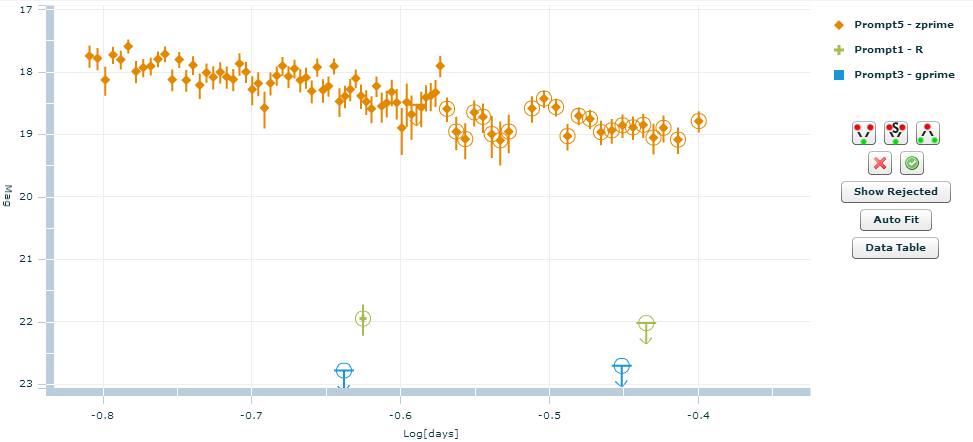
- GCN Circular #14816
D. Xu (DARK/NBI), D. Malesani (DARK/NBI), S. Schulze (PUC and MCSS),
J. P. U. Fynbo (DARK/NBI), Valerio D'Elia (ASI-SDC, INAF OAR), P.
Goldoni (APC/Univ. Paris 7 and SAp/CEA), O. Hartoog (Amsterdam), J.
Hjorth (DARK/NBI), L. Kaper (Amsterdam), T. Kruehler (DARK/NBI), A. J.
Levan (U. Warwick), B. Milvang-Jensen (DARK/NBI), N. R. Tanvir (U.
Leicester), K. Wiersema (U. Leicester) report on behalf of the
X-shooter GRB GTO collaboration:
We observed the optical afterglow of GRB 130606A (Ukwatta et al., GCN
14781; Jelinek et al., GCN 14782; Xu et al., GCN 14783) using the ESO
VLT equipped with the X-shooter spectrograph. The observations started
on 2013-06-07 at 04:09 UT (i.e., 7.08 hr after the burst). A total
exposure of 6x600 s was obtained, covering the spectral range from
~3000 to ~21000 A.
A continuum is detected redward of ~8410 A in the VIS/NIR arms of the
spectra, consistent with a Lyman alpha dropout at z~5.9, while
discrete transmission is present blueward down to ~6505 A. In the
spectra prominent absorption lines are detected, such as NV, C II, O
I, Si IV, C IV, and Si II, all at a common redshift of z=5.913, fully
consistent with the measurements in Castro-Tirado et al. (GCN 14796)
and Lunnan et al. (GCN 14798). We also identified at least two
intervening absorbers at z=3.451 and at z=2.310 through Mg II and Fe
II, respectively.
We thank the Paranal staff for enthusiastic support, in particular
Cedric Ledoux and Felipe Gaete.
- GCN Circular #14817
T. Laskar, A. Zauderer, and E. Berger (Harvard) report:
"We observed the position of GRB 130606A (Ukwatta et al; GCN 14781) with
the EVLA beginning on 2013 June 07.30 UT (0.59 days after the burst). At a
mean frequency of 21.8 GHz, we detect a radio source with a preliminary
flux density of ~ 0.1 mJy at
RA = 16:37:35.134 +/- 0.004
Dec = 29:47:46.47 +/- 0.06,
consistent with the enhanced Swft/XRT position (Burrows et al.; GCN 14812),
the NIR position (Xu et al.; GCN 14783, Nagayama et al.; GCN 14784), and
the optical position (Masi and Nocentini; GCN 13891, Leonini et al.; GCN
14791). Follow-up observations are planned."
- GCN Circular #14818
Klotz A. (IRAP-CNRS-OMP), Gendre B. (IRAP-CNRS-OMP),
Boer M., Siellez K., Dereli H., Bardho O. (UNS-CNRS-OCA),
Atteia J.L. (IRAP-CNRS-OMP) report:
We imaged the field of GRB 130606A detected by SWIFT
(trigger 557589) with the TAROT robotic telescope (D=25cm)
located at the Calern observatory, France.
The observations started 7.1 min after the GRB trigger
The elevation of the field increased from
63 degrees above horizon and weather conditions
were good.
We detect the optical transient (OT) discovered by
Jelinek et al. (GCNC 14782). TAROT images are unfiltered.
The redshift 5.9 means the OT should emit mainly in the I band.
At the present level of analysis we can not give the
flux of the OT refered in the I band.
We choose the zero point of magnitudes using
the star NOMAD-1 1197-0254828 (R=16.43). We refer the TAROT
magnitudes to the R magnitude of the reference star
(we use CR as the symbol of the clear filtered image
calibrated with the R magnitude of the reference star).
At 7.85 minutes after the GRB, CR=17.1
The OT is measured continuously until 141 minutes
with a mean decay of 0.9.
This message may be cited.
- GCN Circular #14819
S. D. Barthelmy (GSFC), W. H. Baumgartner (GSFC/UMBC),
J. R. Cummings (GSFC/UMBC), E. E. Fenimore (LANL),
N. Gehrels (GSFC), H. A. Krimm (GSFC/USRA),
A. Y. Lien (NASA/GSFC/ORAU), C. B. Markwardt (GSFC),
D. M. Palmer (LANL), T. Sakamoto (AGU), G. Sato (ISAS),
M. Stamatikos (OSU), J. Tueller (GSFC), T. N. Ukwatta (MSU)
(i.e. the Swift-BAT team):
Using the data set from T-240 to T+962 sec from the recent telemetry
downlink,
we report further analysis of BAT GRB 130606A (trigger #557589)
(Ukwatta, et al., GCN Circ. 14781). The BAT ground-calculated position is
RA, Dec = 249.390, 29.796 deg which is
RA(J2000) = 16h 37m 33.6s
Dec(J2000) = +29d 47' 44.5"
with an uncertainty of 2.0 arcmin, (radius, sys+stat, 90% containment).
The partial coding was 96%.
The mask-weighted light curve shows multiple peaks. The first peak starts
around T-5 secs and last for 15 seconds, a cluster of weak peaks can be seen
from T+80 sec to T+110 sec, bright two peak structure is seen from T+150 sec
to T+ 170 sec, finally very weak extended multi-peak structure is observed
beyond
T+200 sec up to T+500 sec. T90 (15-350 keV) is 276.58 +- 19.31 sec
(estimated error including systematics).
The time-averaged spectrum from T-1.34 to T+297 sec is best fit by a simple
power-law model. The power law index of the time-averaged spectrum is
1.52 +- 0.12. The fluence in the 15-150 keV band is 2.9 +- 0.2 x 10^-6
erg/cm2.
The 1-sec peak photon flux measured from T+160.36 sec in the 15-150 keV band
is 2.6 +- 0.2 ph/cm2/sec. All the quoted errors are at the 90% confidence
level.
The results of the batgrbproduct analysis are available at
http://gcn.gsfc.nasa.gov/notices_s/557589/BA/
- GCN Circular #14824
Nat Butler (ASU), Alan M. Watson (UNAM), Alexander Kutyrev (GSFC), Willia=
m
H. Lee (UNAM), Michael G. Richer (UNAM), Chris Klein (UCB), Ori Fox (UCB)
J. Xavier Prochaska (UCSC), Josh Bloom (UCB), Antonino Cucchiara (UCSC),
Eleonora Troja (GSFC), Owen Littlejohns (ASU), Enrico Ramirez-Ruiz (UCSC)=
,
Jos=E9 A. de Diego (UNAM), Leonid Georgiev (UNAM), Jes=FAs Gonz=E1lez (UN=
AM),
Carlos Rom=E1n-Z=FA=F1iga (UNAM), Neil Gehrels (GSFC), and Harvey Moseley=
(GSFC)
report:
We observed the field of GRB 130606A (Ukwatta, et al., GCN 14781) with th=
e
Reionization and Transients Infrared Camera (RATIR; www.ratir.org) on the
1.5m Harold Johnson Telescope at the Observatorio Astron=F3mico Nacional =
on
Sierra San Pedro M=E1rtir from 2013/06 8.18 to 2013/06 8.46 UTC (31.14 to
37.86 hours after the BAT trigger), obtaining a total of 4.96 hours
exposure in the r' and i' bands and 2.07 hours exposure in the Z, Y, J, a=
nd
H bands.
The optical/NIR afterglow (Jelinek, et al., GCN 14782; Xu et al., GCN
14783) is well detected. In comparison with SDSS DR9 and 2MASS, we obta=
in
the following detections and 3-sigma upper limit:
r' >24.06
i' 24.06 +/- 0.27
Z 21.50 +/- 0.09
Y 21.41 +/- 0.12
J 21.16 +/- 0.12
H 20.78 +/- 0.12
These magnitudes are in the AB system and not corrected for Galactic
extinction in the direction of the GRB. In comparison to our observation=
s
on the previous night (2013/06/07; Butler, et al., GCN 14799), the
afterglow has faded by about 3 magnitudes in all bands.
We thank the staff of the Observatorio Astron=F3mico Nacional in San Pedr=
o
M=E1rtir.
- GCN Circular #14826
A. Trotter, A. LaCluyze, D. Reichart, J. Haislip, T. Berger, M. Carroll,
H. T. Cromartie, R. Egger, A. Foster, C. Foster, N. Frank, K. Ivarsen,
D. James, M. Maples, J. Moore, M. Nysewander, E. Speckhard, P. Taylor
and J. A. Crain report:
Skynet continued observing the field of GRB 130606A (Ukwatta et al., GCN
14781, Swift trigger #557589), using the optical localization of Xu et
al. (GCN 14783). It took 109 160-second exposures in the z' band with
one of the 16" telescopes of the PROMPT array at CTIO, Chile, with a
mean time t=1.3d post-trigger.
In a stack of all 109 exposures, we detect the afterglow at the 5-sigma
level, with z'~20.5 at t=1.3d. Together with the z' detections we
reported in Trotter et al. (GCN 14815), this implies an approximate
temporal index alpha~-1.2. A preliminary light curve of both nights'
data is at:
http://www.skynet.unc.edu/grb/grb130606a_2.png
Photometry is calibrated to 10 SDSS stars in the field; g' and z'
magnitudes are in the AB system; R-band magnitudes are in the Vega
system, with the SDSS calibration stars transformed according to Jester
(2005). No correction has been applied for the expected line-of-sight
Milky Way extinction of E(B-V)=0.02 (Schlegel et al. 1998).
No further Skynet observations are scheduled.
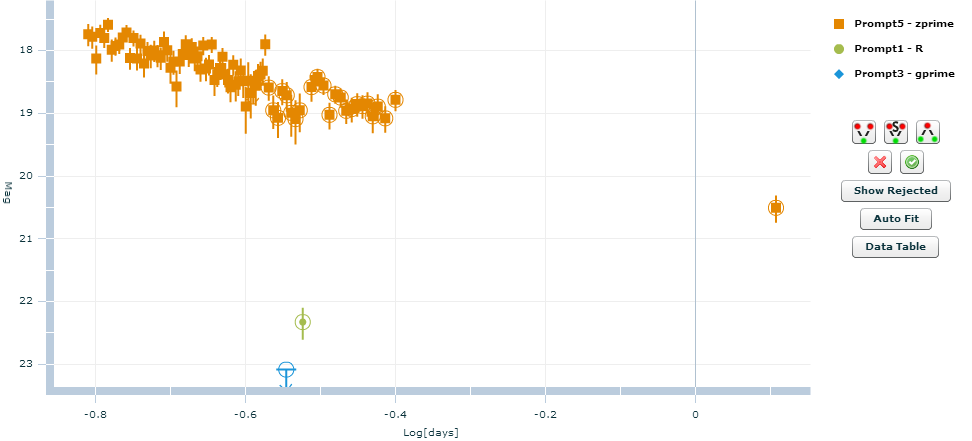
- GCN Circular #14840
F.J. Virgili, C.G. Mundell (LJMU), A. Melandri (INAF-OAB), and A. Gomboc
(U. Ljubljana) report:
Observations of GRB 130606A (Ukwatta et al., GCN 14781) with the 2-m=20
robotic Liverpool Telescope automatically performed between 48 and 80=20
minutes after the GRB trigger confirms a detection of the afterglow in=20
the r'-band with magnitude
r' =3D 21.9 =B1 0.29 at 49.95 minutes
consistent with reported values at similar epochs (Xu et al. 14783) and=20
dimmer than times around 100 minutes post trigger (Leonini et al., GCN=20
14791; Masi et al., GCN 14789; Sonbas et al., GCN 14797), possibly=20
indicating mild re-brightening. This detection clarifies that the=20
afterglow has not yet dropped out of the r'-band at the times coincident=20
with our i' and z' band detections (Virgili et al., GCN 14785) and=20
continues to be detected until at least 6.4 hrs after the initial=20
trigger (Afonso et al., GCN 14807).
In addition, the 2-m Faulkes Telescope North and Liverpool Telescope=20
performed late-time follow up observations, resulting in a 3-sigma=20
upper-limit of
r' > 23.4 at 849.73 min (14.16 hr post-trigger; FTN)
r' > 24 at 1683.67 minutes (=3D 28.06 hr; LT)
and an additional i'-band detection of
i' =3D 23.76 =B1 0.22 @ 28.60 hr (=3D 1716.51 minutes; LT),
in a co-added series of 6x300s exposures, which are consistent with=20
values reported by Trotter et al. (GCN 14815) and Butler et al. (GCN=20
14824). FTN images have been acquired with the R-Bessell filter and=20
calibrated against nearby SDSS catalogue stars.
- GCN Circular #14864
V. Rumyantsev (CrAO), N.Pit' (CrAO), =D0=90. Volnova (IKI), A. Pozanenko
(IKI)
report on behalf of larger GRB follow-up collaboration:
We observed the field of the Swift GRB 130606A (Ukwatta et al., GCN
14781) with AZT-11 telescope of CrAO observatory starting on June 06
(UT) 21:59:60. We took several images in R-filter of 180 s exposure. The
afterglow (Jelinek et al., GCN 14782; Xu et al., GCN 14783; Nagayama et
al., GCN 14784) is not detected in a combined image. A photometry is
based on the same SDSS stars we used in GCN 14806:
Start T0+, Filter Exposure, OT, UL (3 sigma)
UT mid, d (s)
21:59:60 0.0489 R 10x180 n/d 20.7
- 1306.3949 from 18 Jun 13
Ryan Chornock et al.: GRB 130606A as a Probe of the Intergalactic Medium and the Interstellar Medium in a Star-forming Galaxy in the First Gyr After the Big
We present high signal-to-noise ratio Gemini and MMT spectroscopy of the optical afterglow of the gamma-ray burst (GRB) 130606A at redshift
z=5.913, discovered by Swift. This is the first high-redshift GRB afterglow to have spectra of comparable quality to those of z~6 quasars. The
data exhibit a smooth continuum at near-infrared wavelengths that is sharply cut off blueward of 8410 Angs due to absorption from Ly-alpha at
redshift z~5.91, with some flux transmitted through the Ly-alpha forest between 7000-7800 Angs. We use column densities inferred from metal
absorption lines to constrain the metallicity of the host galaxy between a lower limit of [Si/H]>-1.7 and an upper limit of [S/H]<-0.5 set by
the non-detection of S II absorption. We demonstrate consistency between the dramatic evolution in the transmission fraction of Ly-alpha seen
in this spectrum over the redshift range z=4.9 to 5.85 with that previously measured from observations of high-redshift quasars. There is an
extended redshift interval of Delta-z=0.12 in the Ly-alpha forest at z=5.77 with no detected transmission, leading to a 3-sigma upper limit on
the mean Ly-alpha transmission fraction of <0.2% (or tau_eff(Ly-alpha) > 6.4). This is comparable to the lowest-redshift Gunn-Peterson troughs
found in quasar spectra. Some Ly-beta and Ly-gamma transmission is detected in this redshift window, indicating that it is not completely
opaque, and hence that the IGM is nonetheless mostly ionized at these redshifts. GRB 130606A thus for the first time realizes the promise of
GRBs as probes of the first galaxies and cosmic reionization.
- GCN Report 444.1
GCN_Report 444.1 has been posted:
http://gcn.gsfc.nasa.gov/reports/report_444_1.pdf
by T.N. Ukwatta
at MSU
titled: "Swift Observations of GRB 130606A"
- GCN Circular #15230
W. Fong, T. Laskar, E. Berger, and R. Margutti (Harvard) report:
"We observed GRB 130606A (Ukwatta et al., GCN 14781) with the Chandra ACIS
instrument, starting on 2013 June 17 03:05:37 UT (10.3 days after the GRB
trigger), for a total exposure of 30 ks. We detect a point source at the
position of the Swift/XRT afterglow. Using the spectral parameters from the
Swift/XRT PC-mode spectrum (http://www.swift.ac.uk/xrt_products/00557589)
and a redshift of z=5.91 (Chornock et al. 2013, ApJ, 774, 26; Castro-Tirado
et al., GCN 14796; Lunnan et al., GCN 14798; Xu et al., GCN 14816), we find
an unabsorbed flux of (2.4 +/- 0.4)e-15 erg/(s cm^2) in the 0.3-10 keV
band. This measurement is consistent with an extrapolation of the Swift/XRT
observations and shows a continuing decline in flux with a power-law decay
slope of -1.8 +/- 0.1 between 0.1 and 10 days after the burst.
We thank Harvey Tananbaum for approving our DDT request and the CXC staff
for rapidly arranging and executing the observations."
- 1312.3934 from 16 Dec 13
Tomonori Totani et al.: Probing Intergalactic Neutral Hydrogen by High Precision Analysis of the Red Damping Wing of Gamma-Ray Burst 130606A Afterglow Spectrum
The unprecedentedly bright optical afterglow of GRB 130606A at a redshift close to the reionization era (z = 5.913) provides a new opportunity
to probe the ionization status of intergalactic medium (IGM). Here we present a high-precision analysis of the red Ly alpha damping wing of the
afterglow spectrum taken by Subaru/FOCAS during 10.4-13.2 hr after the burst. We find that the minimal model including only the baseline
power-law and HI absorption in the host galaxy does not give a good fit, leaving residuals showing concave curvature in 8400-8900 A with an
amplitude of about 0.6% of the flux. Such a curvature in the short wavelength range cannot be explained either by extinction at the host with
standard extinction curves or by the known systematic uncertainties in the observed spectrum. The red damping wing by intervening HI gas
outside the host can reduce the residual by about 3 sigma statistical significance. We find that a damped Ly alpha system is not favored as the
origin of this intervening HI absorption, from the observed Ly beta and metal absorption features. Therefore absorption by diffuse IGM remains
as a plausible explanation. A fit by a simple uniform IGM model requires HI neutral fraction of f_{HI} ~ 0.1-0.5 depending on the distance to
the GRB host, implying high f_{HI} IGM associated with the observed dark Gunn-Peterson (GP) troughs. This gives a new evidence that the
reionization is not yet complete at z ~ 6. Further investigations using more GRB afterglows to various sightlines, in comparison with realistic
theoretical simulations, are desirable.
- 1312.5631 from 20 Dec 13
A. J. Castro-Tirado et al.: GRB 130606A within a sub-DLA at redshift 5.91
Events such as GRB130606A at z=5.91, offer an exciting new window into pre-galactic metal enrichment in these very high redshift host galaxies.
We study the environment and host galaxy of GRB 130606A, a high-z event, in the context of a high redshift population of GRBs. We have obtained
multiwavelength observations from radio to gamma-ray, concentrating particularly on the X-ray evolution as well as the optical photometric and
spectroscopic data analysis. With an initial Lorentz bulk factor in the range \Gamma_0 ~ 65-220, the X-ray afterglow evolution can be explained
by a time-dependent photoionization of the local circumburst medium, within a compact and dense environment. The host galaxy is a sub-DLA (log
N (HI) = 19.85+/-0.15), with a metallicity content in the range from ~1/7 to ~1/60 of solar. Highly ionized species (N V and Si IV) are also
detected. This is the second highest redshift burst with a measured GRB-DLA metallicity and only the third GRB absorber with sub-DLA HI column
density. GRB ' lighthouses' therefore offer enormous potential as backlighting sources to probe the ionization and metal enrichment state of
the IGM at very high redshifts for the chemical signature of the first generation of stars.
- 1409.4804 from 18 Sep 14
O. E. Hartoog et al.: VLT/X-shooter spectroscopy of the afterglow of GRB 130606A: Chemical abundances and reionisation at $z\sim6$
The reionisation of the universe is thought to have ended around z~6, as inferred from spectroscopy of distant bright background sources such
as quasars (QSO) and gamma-ray burst (GRB) afterglows. Furthermore, spectroscopy of a GRB afterglow provides insight in its host galaxy, which
is often too dim and distant to study otherwise. We present the high S/N VLT/X-shooter spectrum of GRB130606A at z=5.913. We aim to measure the
degree of ionisation of the IGM between 5.025.6. GRBs are useful probes of the IGM ionisation state of the early Universe, but because of internal
scatter we need a larger statistical sample to draw robust conclusions. The high [Si/Fe] in the host can be due to dust depletion,
alpha-element enhancement or a combination. The very high value of [Al/Fe]=2.40+/-0.78 might be connected to the stellar population history. We
estimate the host metallicity to be -1.5<[M/H]<-1.2 (3%-6% of solar). [truncated]
- 1508.05067 from 21 Aug 15
Tomonori Totani et al.: High Precision Analyses of Lyman alpha Damping Wing of Gamma-Ray Bursts in the Reionization Era: On the Controversial Results from GRB 130606A at z = 5.91
The unprecedentedly bright afterglow of GRB 130606A at z = 5.91 gave us a unique opportunity to probe the reionization era by high precision
analyses of the redward damping wing of Lyman alpha absorption, but the reported constraints on the neutral hydrogen fraction (f_{HI}) in
intergalactic medium (IGM) derived from spectra taken by different telescopes are in contradiction. Here we examine the origin of this
discrepancy by analyzing the spectrum taken by VLT with our own analysis code previously used to fit the Subaru spectrum. Though the VLT team
reported no evidence for IGM HI using the VLT spectrum, we confirmed our previous result of 3-4 sigma preference for non-zero IGM HI (f_{HI} ~
0.06, when IGM HI extends to the GRB redshift). The fit residuals of the VLT spectrum by the model without IGM HI show the same systematic
trend as the Subaru spectrum. We consider that the likely origin of the discrepancy between the two teams is the difference of the wavelength
ranges adopted in the fittings; our wavelength range is wider than that of the VLT team, and also we avoided the shortest wavelength range of
deep Lyman alpha absorption (lambda_{obs} < 8426 A), because this region is dominated by HI in the host galaxy and the systematic uncertainty
about host HI velocity distribution is large. We also study the sensitivity of these results to the adopted Lyman alpha cross section formulae,
ranging from the classical Lorentzian function to the most recent one taking into account fully quantum mechanical scattering. It is found that
the preference for non-zero IGM HI is robust against the choice of the cross section formulae, but it is quantitatively not negligible and
hence one should be careful in future analyses.
- 1512.07808 from 25 Dec 15
J. T. W. McGuire et al.: Detection of three Gamma-Ray Burst host galaxies at $z\sim6$
Gamma-ray bursts allow us to pinpoint and study star-forming galaxies in the early universe, thanks to their immense luminosities and
association with deaths of massive stars. We present {\em Hubble Space Telescope} Wide Field Camera 3 detections of three {\em Swift} GRBs
lying at redshifts $z = 5.913$ (GRB 130606A), $z = 6.295$ (GRB 050904), and $z = 6.327$ (GRB 140515A) in the F140W (wide-$JH$ band,
$\lambda_{\rm{obs}}\sim1.4\,\mu m$) filter. The hosts have magnitudes (corrected for Galactic extinction) of $m_{\rm{\lambda_{obs},AB}}=
26.26^{+0.12}_{-0.14}, 27.63^{+0.16}_{-0.18},$ and $28.23^{+0.24}_{-0.30}$ respectively. In all three cases the probability of chance
coincidence of lower redshift galaxies is $\lesssim1.5\%$, indicating that the detected galaxies are most likely the GRB hosts. These are the
first detections of high redshift ($z > 5$) GRB host galaxies in emission. The galaxies have luminosities in the range $0.1-0.7\,L^{*}_{z=6}$
(with $M_{1600}^{*}=-20.95\pm0.12$), along with half-light radii in the range $0.6-1.2\,\rm{kpc}$. Both their half-light radii and luminosities
are consistent with existing samples of Lyman-break galaxies at $z\sim6$. Spectroscopic analysis of the GRB afterglows indicate low
metallicities ($[\rm{M/H}]\lesssim-1$) and dust extinction ($A_{\rm{V}}\lesssim0.1$) along the line of sight. We consider the implications of
these luminosities for their possible star formation histories and the potential for emission line metallicity determinations with {\em James
Webb Space Telescope} spectroscopy.
![]() Previous IAU Circulars
Previous IAU Circulars 













